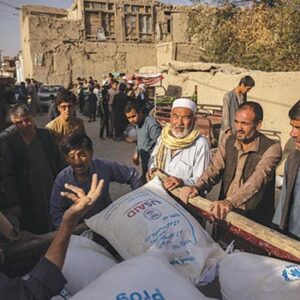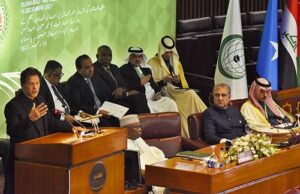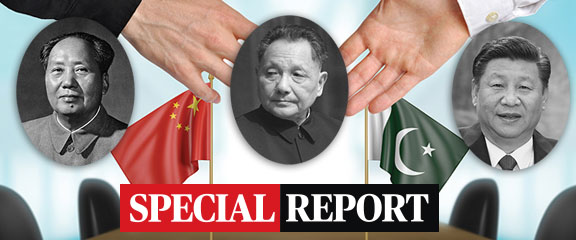The roadmap for international engagement with Afghanistan became clearer with three major developments within the last two weeks of December: the OIC (Organisation of Islamic Cooperation) Foreign Minister’s Conference in Islamabad; a US-proposed UNSC (United Nations Security Council) resolution passed unanimously; and the US Treasury’s concessions on American-origin financial aid flows to the crisis-ridden Afghanistan.
The Treasury Department announced that it was issuing more licenses to facilitate the flow of international aid to Afghanistan “as long as it did not reach individuals sanctioned by the U.S.” The licenses will also enable the Afghan diaspora to use banking channels for sending funds to their families in Afghanistan. Additionally, they would help the transfer of European Union (EU) funds (one billion Euros) through banking channels.
This move in Washington on December 22 ensued following a string of appeals and pressures, particularly from within, including a letter by 46 mostly Democratic lawmakers who warned President Biden that “sanctions against Taliban officials now in charge of governmental functions are creating a chilling effect for financial institutions and aid organisations serving Afghanistan.”

The UNSC resolution was equally promising. It said: “This resolution provides an exemption from the U.N. Security Council assets freeze against listed members of the Taliban and associated entities solely for the provision of humanitarian assistance and other activities that support basic human needs in Afghanistan, which the council will review in one year.”
What does all this mean for the months ahead, if not years?
Scenario 1:
Based on the aforementioned three major developments, one can assume more soft-pedalling vis-a-vis the Taliban by the United States and its major European allies. This will facilitate the inflow of the one billion Euros the EU has committed plus the roughly $480 million pledged by the United States.
The Afghan economy continues to slide; businesses have contracted by nearly 50 percent since mid-August; the national currency, the Afghani, continues to lose its value vis-a-vis the dollar; and the $9.5 billion assets belonging to the Afghan central-bank remain frozen in the United States. Consequently, the Taliban regime remains financially hamstrung by the above factors. However, the United Nations receives a substantial part of the $8 billion that it has asked for to provide aid and services to Afghanistan in 2022, through a parallel aid and service delivery system.
Unwillingly, the Taliban have agreed to the parallel UN-led delivery system, also assisted by the OIC, because they lack international legitimacy. And further, they lack the funds to freely run the government.
Contracted businesses, unemployment and worsening economic conditions have resulted in increased crime and poppy production. Smuggling from Pakistan and Iran have also picked up.
At the same time, ties with Pakistan are getting tense because the Taliban —through their anti-Pakistan vitriol — are trying their best shake off the tag of being “Pakistan’s proxies.” This is further sullying Pakistan’s image internationally. Their lack of action against the Tehreek-e-Taliban Pakistan (TTP) is another irritant in bilateral relations. Elements within the Taliban circles, particularly opportunistic factions who jumped on the bandwagon after August 15, keep reviving historically contentious issues, such as the Durand Line, to vitiate the air between the two countries.

The Taliban face little political opposition, but there is a groundswell of public resentment against them because of starvation, unemployment, and a regular exodus of desperate Afghans who do not see any future for themselves.
But despite all these handicaps, the Taliban regime continues to survive and moves on in a helter-skelter manner, hanging by a thread. Fortunately for them, there is little political opposition, because the US and its allies refuse to financially support any anti-Taliban forces. But they withhold recognition because their primary objective is to keep the Taliban regime on a leash while providing the bare-minimum support.
So the Taliban, who have improved revenue collection and contained corruption, muddle along on a shoe-string budget as the Biden administration grapples with the issue of whether to recognise the Taliban or not.
Scenario 2:
Despite receiving massive humanitarian assistance, social unrest against the intransigent Taliban regime mounts. The economy is continuously contracting. The assets remain frozen and Afghanistan’s international banking capacity is constrained because of US sanctions and the designation of the Taliban as terrorists by the UN.
Corruption is on the rise because the Taliban lack financial resources. The flow of UN-led humanitarian assistance, nevertheless, is dependent on official sweet will, which serves as a perverse incentive for the officials who hold the key to distribution and disbursement of aid and salaries. This means more official corruption — and the aid officials are in the habit of greasing palms in order to be seen as “successfully performing the aid distribution task.”
Relations with Pakistan remain sour and complex. The Taliban are trying to leverage relative international goodwill to keep Pakistan at a distance. Random officials keep denigrating Pakistan to appear as “sons of the soil” — obvious attempts to deflect public criticism and to create acceptance among common Afghans, particularly the younger generation that sees its eastern neighbour as the source of Afghanistan’s ills.
The disconnect between the younger population and the rulers is growing. Any Afghan who has a choice, is anxious to leave the country for a better future. This represents extreme socio-political volatility for the Taliban. It also means continued pressure on Pakistan’s borders because of the flight of all those who are anxiously seeking opportunities to get out.
Common to Both Scenarios
The general socio-economic conditions are deteriorating, making the political situation messier for the regime. This represents an ideal situation for the opponents of China and Pakistan to fish for influence among the Taliban.
In their desperation, they are leveraging China and Pakistan’s desire for stability in Afghanistan with an overzealous Indo-US alliance that wants to deny China, in particular, any foothold in Afghanistan.
This works in the Taliban regime’s favour, as they are getting indirect concessions from the US, which would hate to see China and Russia cultivate the Taliban regime to expand their sphere of influence. Will this geo-political contest be a bane or a boon for the Taliban? The first few months of 2022 will make it abundantly clear. Most of the elite — politicians as well as highly paid bureaucrats/diplomats who fled the country — are positioning themselves for scenario 11. However, one thing is clear regarding the immediate future — the Taliban face no literal fighting opposition as most of them have left the country and those who are still inside are fatigued with the perennial state of conflict. So, unless external vested interests intervene with funding, the Taliban face no real military opponent.

The writer is the founder and Executive Director of the Centre for Research and Security Studies.



